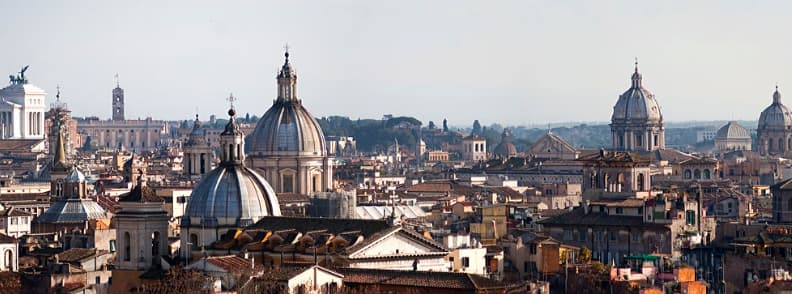The cathedrals and churches in Rome are beautiful historic places, some of them built over ancient temples. Most of them are large and imposing, but there are also some small, intimate constructions, too. And, despite having this list of 45 churches in Rome, I only covered the most interesting and/or most famous ones on this page of the Rome travel guide.
For each of these cathedrals and churches in Rome, you will find:
- the name of the Roman church and an image;
- a short description of that Roman church;
- visiting information including opening times, ticket prices, address and map location, telephone if available, and details on how to get to each of these churches in Rome using public transport.
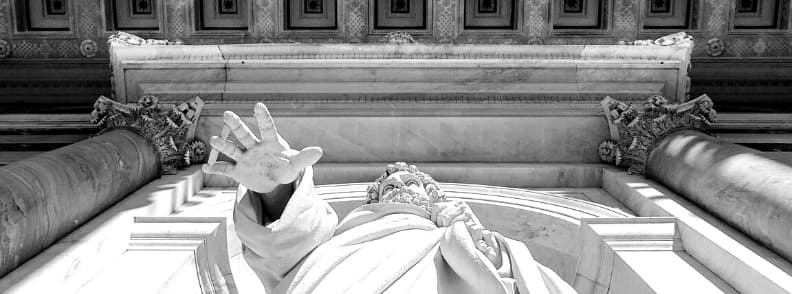
Archbasilica of Saint John in Lateran (Basilica di San Giovanni in Laterano)
Basilica di San Giovanni in Laterano, the cathedral of the diocese in Rome was founded by Emperor Constantine in the 4th century. Until 1309, this was the main papal residence and the popes were actually crowned here up until the 19th century.
The renovation from the 1650s explains the Bombastic baroque style that is still present today. You can notice it both in the gestures and in the attitudes of the oversized saints.
Not far from here, there is a construction called Scala Santa. Brought from Jerusalem by Hellen, the mother of Emperor Constantine, these stairs are said to be the ones where Jesus was convicted. Nowadays, believers climb the Scala Santa on their knees while they ardently pray.
Tickets, opening times, and other useful information
Opening times
The Basilica di San Giovanni in Laterano is open daily, between 07.00 and 18.30.
The Scala Santa is open on weekdays between 06.00 and 14.00, then between 15.00 and 18.30.
Tickets
Admission to the Basilica di San Giovanni in Laterano is free of charge.
However, a full admission ticket to visit the cloister costs €2.00.
Basilica di San Giovanni in Laterano
Address: Piazza di S. Giovanni in Laterano, 4, 00184 Roma RM, Italy | See on map
Public transport: The subway station San Giovanni is within walking distance. Buses 16, 81, 85, 87, and 665 also have stops nearby.
Tel. +39 06 6988 6433
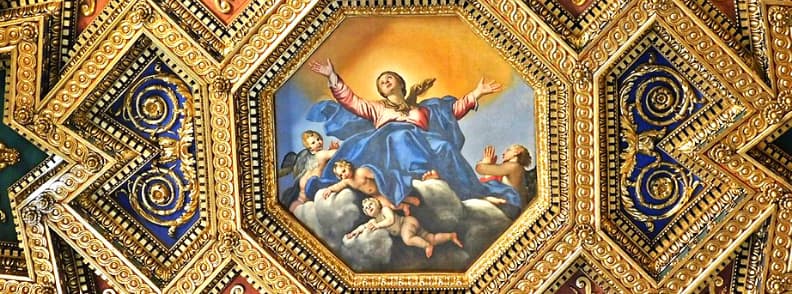
Photo by Fczarnowski [CC BY-SA 3.0]
Basilica of Our Lady in Trastevere (Basilica di Santa Maria in Trastevere)
This is probably the oldest church in Rome. It’s definitely one of the most intimate and charming ones! It’s the only medieval church in Rome that hasn’t been modified by baroque style enthusiasts at all.
The Basilica of Santa Maria in Trastevere dates back to Pope Callistus I and it is an early center of worship of the Virgin Mary. Legend has it that Santa Maria in Trastevere was founded on the spot where olive oil came out of the ground the day that Jesus was born. The miracle is portrayed through the wonderful mosaics entitled The Life of the Holy Virgin that Pietro Cavallini created in 1291.
In the chapel to the left of the altar there is a rare painted panel from the 17th century, showing Madonna Della Clemenza. The floor is in the style of the Cosmati artisans.
Tickets, opening times, and other useful information
Opening times
The Basilica di Santa Maria in Trastevere is open daily, between 07.30 and 21.00.
Tickets
Admission to Basilica di Santa Maria in Trastevere is free of charge.
Basilica di Santa Maria in Trastevere
Address: Piazza di Santa Maria in Trastevere, 00153 Roma RM, Italy | See on map
Public transport: Buses 23, 280, and 780 have stops close to Santa Maria in Trastevere.
Tel. +39 06 581 4802
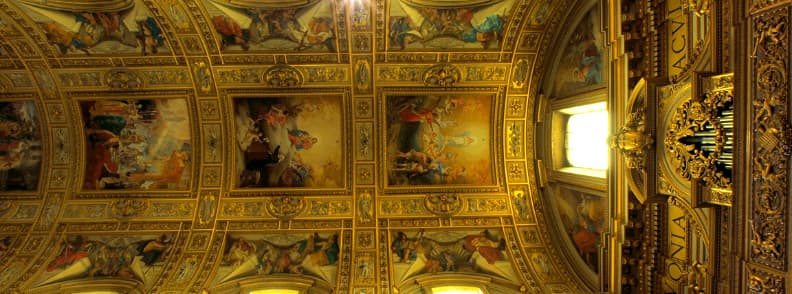
Basilica Saint Andrew of the Valley (Basilica di Sant’Andrea della Valle)
Sant’Andrea della Valle is well-known to many visitors because it’s part of the decorum in the first act of the opera Tosca by Puccini. This edifice of the counter-reform has the second-largest Dome among the churches in Rome.
Inside, Sant’Andrea della Valle has beautiful frescoes by Domenichino. Outside, it has an asymmetrical baroque facade, with the entire structure leaning on the angel statue on the left. That is because Pope Alexander VII harshly critiqued the work of sculptor Cosimo Fancelli, who refused to make a second angel for the right side.
Tickets, opening times, and other useful information
Opening times
The Basilica di Sant’Andrea della Valle is open daily, between 07.00 and 12.30, then between 16.00 and 18.00.
Tickets
Admission to Basilica di Sant’Andrea della Valle is free of charge.
Basilica di Sant’Andrea della Valle
Address: Corso Vittorio Emanuele II, 00186 Roma RM, Italy | See on map
Public transport: Buses 40, 46, 62, 64, 70, 81, 87, 492, 628, and 916 have stops close to Sant’Andrea della Valle.
Tel. +39 06 686 1339
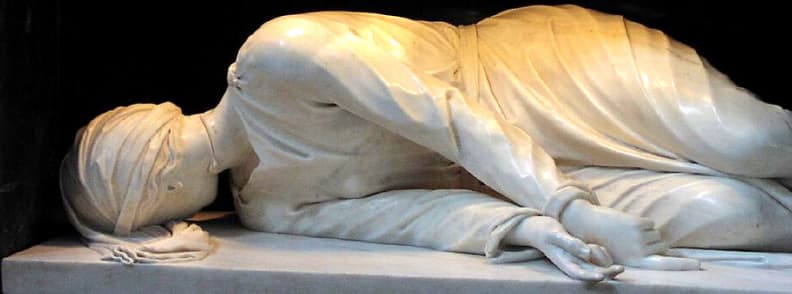
Martyrdom of Saint Cecilia, photo by Stefano Maderno [CC BY 2.0]
Basilica of Saint Cecilia in Trastevere (Basilica di Santa Cecilia in Trastevere)
Santa Cecilia in Trastevere was built on top of the home of Saint Cecilia. Inside, travelers can find a painting by Guido Reni showing the decapitation of Saint Cecilia. There are also 19th-century mosaics and a baldaquin made in 1293 by Arnolfo Cambio.
On the left, one can spot the top of the Final Judgment by Cavallini. It is the only one of his frescoes to have survived to this day.
Tickets, opening times, and other useful information
Opening times
The Basilica di Santa Cecilia in Trastevere is open daily, between 10.00 and 12.30, then between 16.30 and 18.30.
Tickets
Admission to Basilica di Santa Cecilia in Trastevere is free of charge.
Basilica di Santa Cecilia in Trastevere
Address: Piazza di Santa Cecilia, 22, 00153 Roma RM, Italy | See on map
Public transport: Buses 23, 44, and 280 can drop you within walking distance of Santa Cecilia.
Tel. +39 06 589 9289
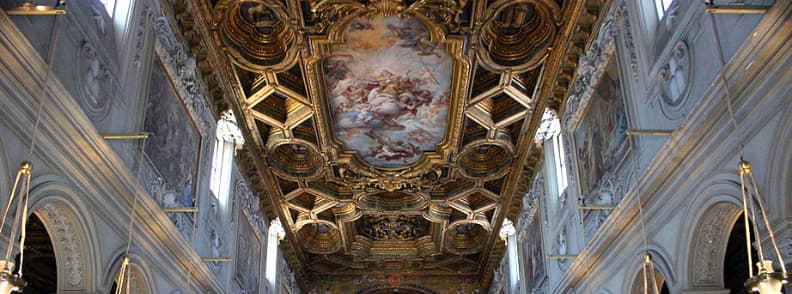
Photo by Miguel Hermoso Cuesta [CC BY-SA 4.0]
Basilica of Saint Clement (Basilica di San Clemente)
There is no other place in Rome that can offer a perspective of how the Eternal City was built layer upon layer. The deepest layer under San Clemente is still mostly unexplored, although it dates back to Republican Rome in the 2nd century BC. On the topmost underground layer, there is a 4th-century church. It is partially intact after it burnt down during the Norman invasion of 1084. The church raised above it, uses some of its original architectural elements.
All that is underground was uncovered in 1857 by a Dominican monk, who started bringing archaeological discoveries to the surface.
San Clemente can take its visitors up to 18 meters underground and over 2,000 back in time.
Tickets, opening times, and other useful information
Opening times
The Basilica di San Clemente is open from Monday to Saturday between 09.00 and 12.30, then between 15.00 and 18.00. On Sunday, it is open after mass to 18.00.
Tickets
A full general admission ticket costs €10.00.
Reduced tickets cost €5.00 and are provided for children under 18 and seniors over 65 years.
Basilica di San Clemente
Address: Via Labicana, 95, 00184 Roma RM, Italy | See on map
Public transport: Subway line B can take you to the nearby Colosseo station. Buses 85, 87, 117, 186, 810, and 850 also have stops close to Basilica di San Clemente.
Tel. +39 06 774 0021
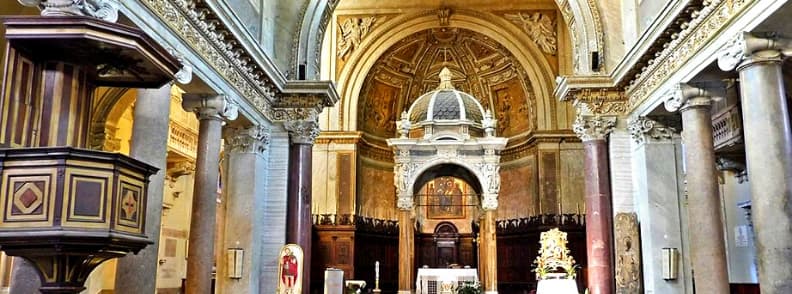
Basilica of Saint Chrysogonus (Basilica di San Crisogono)
The 1625 facade of the Basilica of San Crisogono 1626 is a replica of its initial medieval facade. Inside, visitors can uncover 22 ancient columns plus some excavations from the initial 5th-century church.
Tickets, opening times, and other useful information
Opening times
The Basilica di San Crisogono is open daily, between 07.30 and 12.00, then between 15.30 and 19.00.
Tickets
Admission to the Basilica di San Crisogono is free of charge.
However, a full admission ticket to visit the excavations costs €3.00.
Basilica di San Crisogono
Address: Piazza Sidney Sonnino, 44, 00153 Roma RM, Italy | See on map
Public transport: Buses 23, 280, and H have stops near Basilica di San Crisogono. So does tram 8.
Tel. +39 06 581 0076
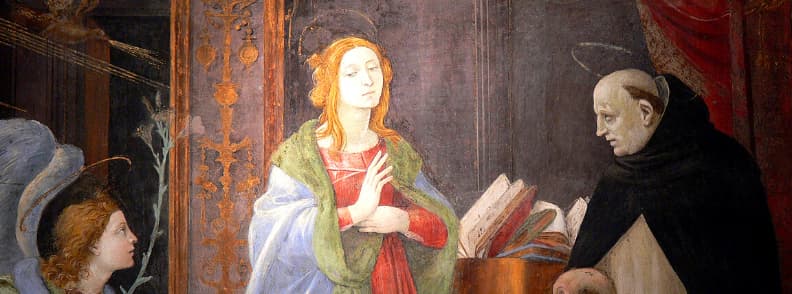
Basilica of Saint Mary above Minerva (Basilica di Santa Maria sopra Minerva)
Built over an ancient temple of wisdom, Santa Maria sopra Minerva is the only Florentine Gothic church in Rome. Raised around 1280 in the 16th century, this basilica was heavily used by the inquisition in Rome.
Inside, visitors can admire works by Michelangelo and frescoes by Filippino Lippi.
Tickets, opening times, and other useful information
The Basilica Santa Maria sopra Minerva is closed indefinitely for restoration works.
Basilica di Santa Maria sopra Minerva
Address: Piazza della Minerva, 42, 00186 Roma RM, Italy | See on map
Public transport: Buses 30, 40, 46, 62, 64, 70, 81, and 87 stop near Basilica di Santa Maria sopra Minerva.
Tel. +39 06 6992 0384
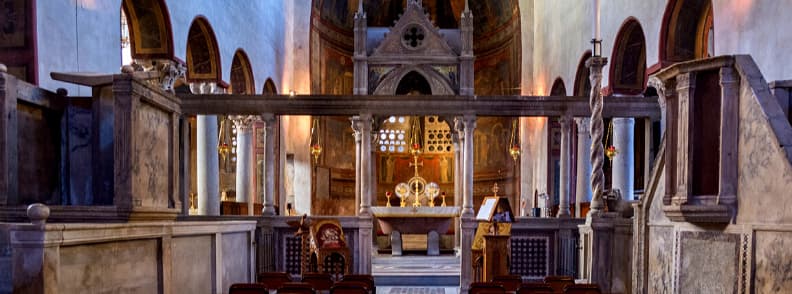
Basilica of Saint Mary in Cosmedin (Basilica di Santa Maria in Cosmedin)
Once a center to distribute bread, Santa Maria in Cosmedin became a church in the 6th century. 200 years later, it became the center of the Greek community exiled in Rome.
A few of the initial decorations were kept, but most of them come from the 12th and 13th centuries. However, the altar panel, specific to the Orthodox churches in Eastern Europe, still remains.
The most popular element of Santa Maria in Cosmedin is located outside. This is La Bocca della Verita, an ancient cover to the water reservoir located underground. Legend says that the stone mouth will eat the hand of liars when they place their palm inside it.
Tickets, opening times, and other useful information
Opening times
The Basilica di Santa Maria in Cosmedin is open daily, between 09.30 and 17.30.
Tickets
Access to Basilica di Santa Maria in Cosmedin is free of charge.
Basilica di Santa Maria in Cosmedin
Address: Piazza della Bocca della Verità, 18, 00186 Roma RM, Italy | See on map
Public transport: Buses 23, 44, 81, 95, 160, 280, 628, 715, and 716 have stops close to Basilica di Santa Maria in Cosmedin.
Tel. +39 06 678 7759
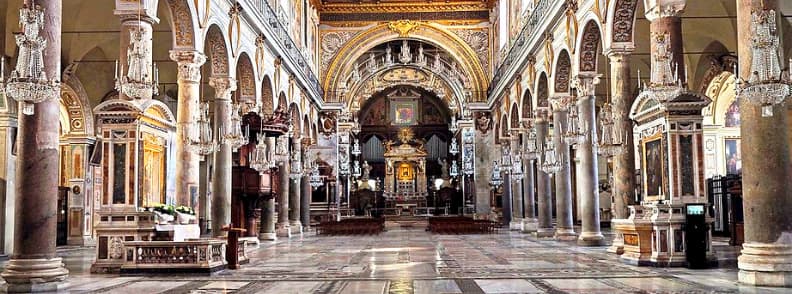
Photo by Peter1936F [CC BY-SA 4.0]
Basilica of Saint Mary of the Altar of Heaven (Basilica di Santa Maria in Aracoeli)
This 16th-century Santa Maria in Aracoeli was raised on the spot of an ancient temple dedicated to Junona Moneta. Legend has it that you can win the lottery if you go up the staircase outside in your knees. But once at the top, everyone wins the chance to see a beautiful view over Rome.
Inside, visitors can admire 22 columns that come from various ancient structures. For example, if you take a closer look at the third one on the left there is writing saying a cubilo augustorum, showing that it comes from Emperor Augusto’s bedroom.
Tickets, opening times, and other useful information
Opening times
The Basilica di Santa Maria in Aracoeli is open daily, between 07.00 and 19.00.
Tickets
Access to Basilica di Santa Maria in Aracoeli is free of charge.
Basilica di Santa Maria in Aracoeli
Address: Scala dell’Arce Capitolina, 12, 00186 Roma RM, Italy | See on map
Public transport: Buses 30, 46, 51, 80, 81, 83, 85, 87, 118, 160, 170, and 628 stop in the vicinity of Basilica di Santa Maria in Aracoeli.
Tel. +39 06 6976 3839
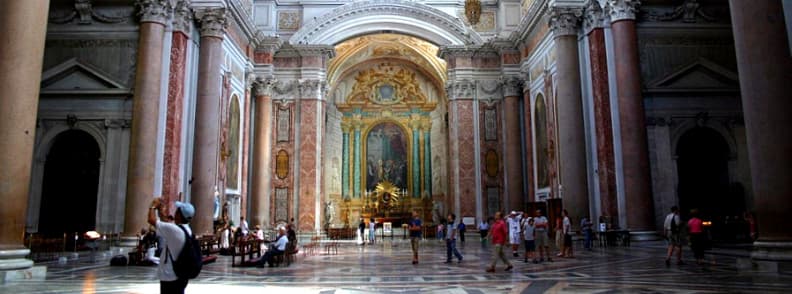
Basilica of Saint Mary of the Angels and the Martyrs (Basilica di Santa Maria degli Angeli e dei Martiri)
In 1561, Michelangelo was ordered by the Pope to change the frigidarium inside the Baths of Diocletian into a church. Michelangelo needed to raise the floor by two meters in order to use the 15-meter rose granite columns he wanted. The result is Basilica di Santa Maria degli Angeli e dei Martiri, an overwhelming space reflecting just how large these Roman public baths actually were.
Tickets, opening times, and other useful information
Opening times
The Basilica di Santa Maria degli Angeli e dei Martiri is open daily, between 07.00 and 19.30.
Tickets
Admission to Basilica di Santa Maria degli Angeli e dei Martiri is free of charge.
Basilica di Santa Maria degli Angeli e dei Martiri
Address: Piazza della Repubblica, 00185 Roma RM, Italy | See on map
Public transport: The subway can take you to the nearby Repubblica station. And buses 64, 70, 82, 85, 170, 590, and 910 also have stops close to Basilica di Santa Maria degli Angeli e dei Martiri.
Tel. +39 06 488 0812
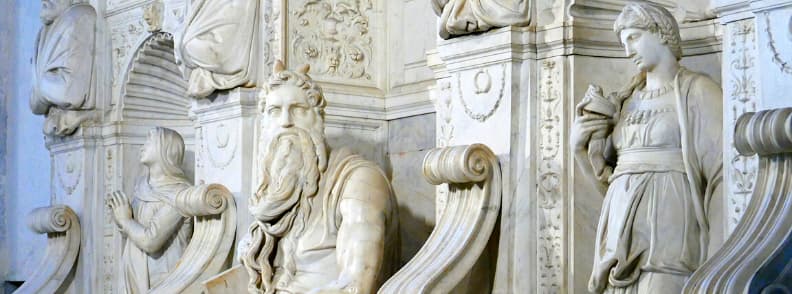
Basilica of Saint Peter in Chains (Basilica di San Pietro in Vincoli)
In the Basilica di San Pietro in Vincoli, travelers can see Moses in the eyes of Michelangelo. Glowing strangely, Moses is angry that the people are not following God’s Commandments and thinking about breaking the stones. This is one of the 40 statues that Michelangelo was supposed to design for the tomb of Pope Julius II. However, his work was left unfinished.
Another piece that catches the eye is the original 4th-century altar. It covers the chains that were supposed to have tied St. Peter when he was imprisoned.
Tickets, opening times, and other useful information
Opening times
Basilica di San Pietro in Vincoli is open daily between 08.00 and 12.30, then between 15.00 and 19.00.
Tickets
Admission to visit Basilica di San Pietro in Vincoli is free of charge.
Basilica di San Pietro in Vincoli
Address: Piazza di San Pietro in Vincoli, 4/a, 00184 Roma RM, Italy | See on map
Public transport: Subway line B will take you to the Cavour station. Buses 75, 84, and 117 also stop close to the Basilica di San Pietro in Vincoli.
Tel. +39 06 9784 4952
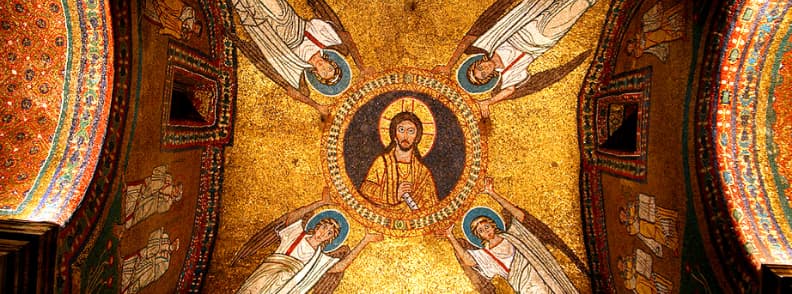
Basilica of Saint Praxedes (Basilica di Santa Prassede)
Santa Prassede was built in the 19th century, over a 2nd-century oratory. Despite multiple restorations, one can still make out the original design.
Inside, there is a stone covering the fountain where it is said that Saint Praxedes buried 2,000 martyrs. There is also a fragment of the column to which Jesus was tied when He had to endure the Passions.
Tickets, opening times, and other useful information
Opening times
The Basilica di Santa Prassede is open daily between 07.00 and 12.00, then between 15.00 and 18.30.
Tickets
Admission to Basilica di Santa Prassede is free of charge.
Basilica di Santa Prassede
Address: Via di Santa Prassede, 9/a, 00184 Roma RM, Italy | See on map
Public transport: 16, 70, 71, 75, 360, 590, 649, and 714 have stops close to Basilica di Santa Prassede.
Tel. +39 06 488 2456
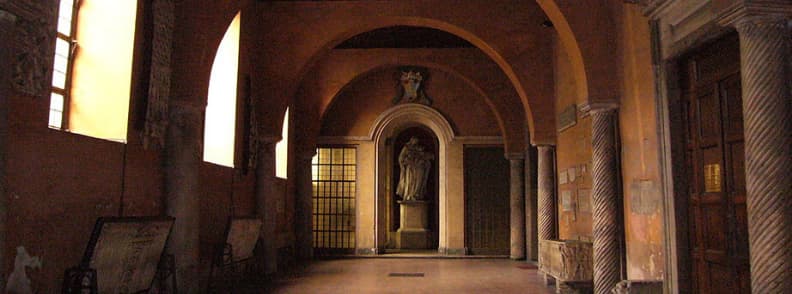
Basilica of Saint Sabina (Basilica di Santa Sabina all’Aventino)
This church was built over a temple of Juno Regina, around the year 425. Between 1936 and 1938, Santa Sabina was massively restored to regain its original look, while keeping the more recent additions from the 9th century.
The 5th-century sculpted wood doors have 18 panels with Bible scenes painted on them. Among them, there is the oldest Crucifixion scene… but with no Cross.
Tickets, opening times, and other useful information
Opening times
The Basilica di Santa Sabina all’Aventino is open between 08.15 and 12.30, then between 15.30 and 18.00.
Tickets
Access to Basilica di Santa Sabina all’Aventino is free of charge.
Basilica di Santa Sabina all’Aventino
Address: Piazza Pietro D’Illiria, 1, 00153 Roma RM, Italy | See on map
Public transport: Buses 23, 51, 81, 85, 87, 118, 160, and 280 have stops that are within walking distance from Basilica di Santa Sabina all’Aventino.
Tel. +39 06 579401
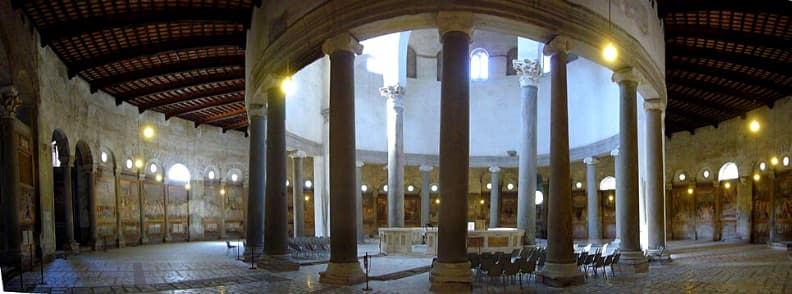
Basilica of Saint Stephen in the Round on the Celian Hill (Basilica di Santo Stefano Rotondo al Celio)
Santo Stefano Rotondo is an early church, raised between 468 and 483. Its unusual shape suggests that it may have been built over the circular meat market Marcellus Magnum. Another possibility is that it was inspired by the church of the Holy Grave in Jerusalem.
Inside, visitors can gaze at 16th-century frescoes by Niccolo Pomarancio.
Tickets, opening times, and other useful information
Opening times
The Basilica di Santo Stefano Rotondo al Celio is open daily, between 10.00 and 13.00, then between 14.00 and 17.00.
Tickets
Admission to the Basilica di Santo Stefano Rotondo al Celio is free of charge.
Basilica di Santo Stefano Rotondo al Celio
Address: Via Santo Stefano Rotondo, 7, 00184 Roma RM, Italy | See on map
Public transport: Bus 81 stops in front of Basilica di Santo Stefano Rotondo al Celio. The subway station Circo Massimo is within walking distance, too.
Tel. +39 06 4211 9130
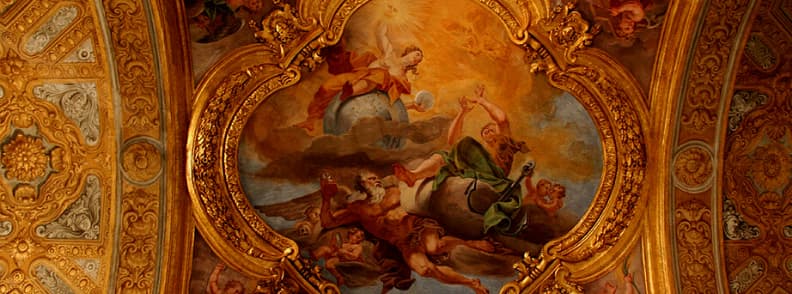
Basilica of Saints Ambrose and Charles at Corso (Basilica dei Santi Ambrogio e Carlo al Corso)
Basilica dei Santi Ambrogio e Carlo al Corso was built in 1669 in the baroque style. The tribune and the dome are the works of Pietro da Cortona.
Tickets, opening times, and other useful information
Opening times
The Basilica dei Santi Ambrogio e Carlo al Corso is open daily, between 07.00 and 19.00.
Tickets
Access to the Basilica dei Santi Ambrogio e Carlo al Corso is free of charge.
Basilica dei Santi Ambrogio e Carlo al Corso
Address: Via del Corso, 437, 00186 Roma RM, Italy | See on map
Public transport: Buses 301 and G30 stop right next to Basilica dei Santi Ambrogio e Carlo al Corso.
Tel. +39 06 6819 2527
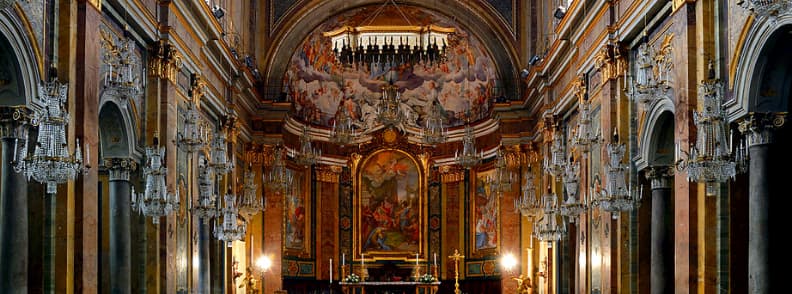
Basilica of Saints John and Paul on the Celian Hill (Basilica Santi Giovanni e Paolo al Celio)
Decapitated at the order of emperor Julian, the Saints became martyrs here in the 4th century. Travelers can still see their house underneath this 5th-century medieval structure.
Tickets, opening times, and other useful information
Opening times
The Basilica Santi Giovanni e Paolo al Celio is open daily, between 08.00 and 13.00, then between 15.00 and 18.00. The restored houses are open on from Thursday to Monday, between 10.00 and 13.00, then between 15.00 and 18.00.
Tickets
Admission to the Basilica Santi Giovanni e Paolo al Celio is free of charge.
Basilica Santi Giovanni e Paolo al Celio
Address: Piazza Dei SS. Giovanni e Paolo, 00184 Roma RM, Italy | See on map
Public transport: Trams 3, 8, and 3L stop close to Basilica Santi Giovanni e Paolo al Celio. Buses 51, 75, 81, 85, and 87 will also drop you within walking distance of this basilica.
Tel. +39 06 700 5745
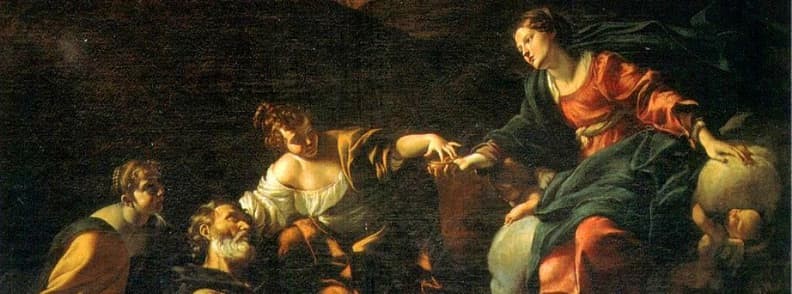
Basilica of Sant’Agostino in Campo Marzio (Basilica di Sant’Agostino in Campo Marzio)
The main piece in Sant’Agostino in Campo Marzio is Madonna del Loretto, by Caravaggio. This work was done between 1603 and 1606. The strict realism of Caravaggio opposes traditional iconography. He is showing Mary on the roof of her flying house that had landed in Loretto. The house itself is only suggested by a travertine doorstep. Mary is portrayed as she is worshiped by a pair of dirty pilgrims.
Another interesting piece can be found on the third pillar on the right. In 1512, Rafael painted a fresco of the Prophet Isaiah here.
Tickets, opening times, and other useful information
Opening times
The Basilica di Sant’Agostino in Campo Marzio is open daily, between 07.45 and 12.00, then between 14.00 and 20.00.
Tickets
Admission to the Basilica di Sant’Agostino in Campo Marzio is free of charge.
Basilica di Sant’Agostino in Campo Marzio
Address: Piazza di S. Agostino, 00186 Roma RM, Italy | See on map
Public transport: Buses 30, 70, 81, 87, 492, and 628 stop near Basilica di Sant’Agostino in Campo Marzio.
Tel. +39 06 6880 1962
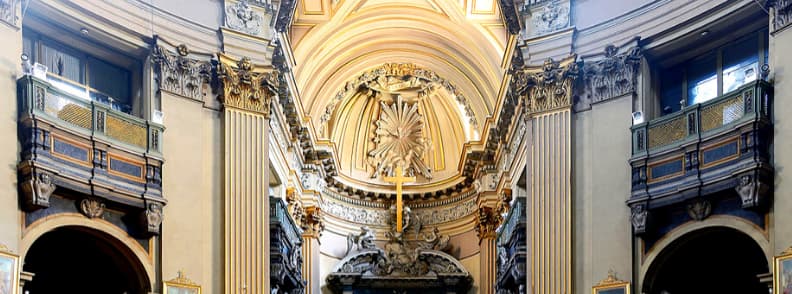
Church of Miracles (Chiesa di Santa Maria dei Miracoli)
Together with Santa Maria in Montesanto, Santa Maria dei Miracoli is one of the twin churches in Piazza del Popolo. Built at the end of the 17th century, it is the work of Carlo Fontana.
Tickets, opening times, and other useful information
Opening times
Chiesa di Santa Maria dei Miracoli is open daily, between 07.00 and 12.30, then between 16.00 and 19.30.
Tickets
Access to the Santa Maria dei Miracoli is free of charge.
Santa Maria dei Miracoli
Address: Via del Corso, 529, 00186 Roma RM, Italy | See on map
Public transport: Bus 119 stops close to Santa Maria dei Miracoli. The subway station Flaminio is within walking distance, too.
Tel. +39 06 361 0250
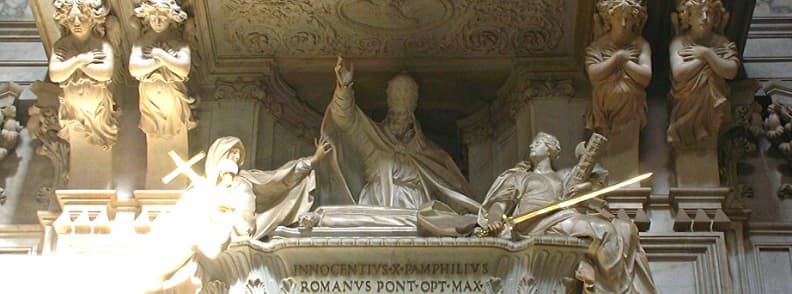
Church of Sant Agnes in Agone (Chiesa di Sant’Agnese in Agone)
Chiesa di Sant’Agnese in Agone was raised in the honor of a 13-year-old girl. Legend has it that she was undressed in a brothel but she immediately and miraculously made her hair grow in order to cover her naked body.
Tickets, opening times, and other useful information
Opening times
Chiesa di Sant’Agnese in Agone is open from Tuesday to Saturday between 09.30 and 12.30, then between 15.30 and 19.00. On Sundays, the church is open between 09.00 and 13.00, then between 16.00 and 20.00. Closed on Mondays.
Tickets
Access to Chiesa di Sant’Agnese in Agone is free of charge.
Chiesa di Sant’Agnese in Agone
Address: Via di Santa Maria dell’Anima, 30/A, 00186 Roma RM, Italy | See on map
Public transport: Buses 30, 70, 81, 87, 492, and 628 stop close to Chiesa di Sant’Agnese in Agone.
Tel. +39 06 6819 2134
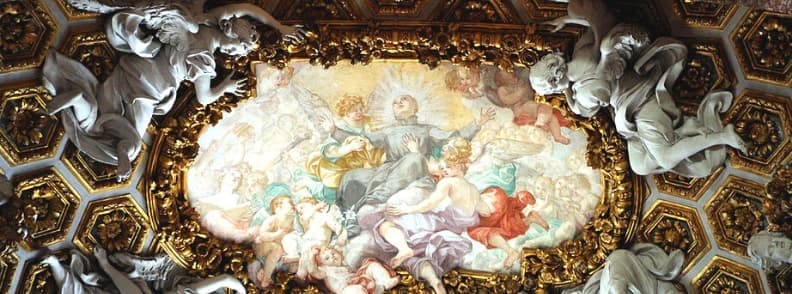
Church of Saint Andrew at the Quirinal (Chiesa di Sant’Andrea al Quirinale)
At the peak of Bernini’s career, this church was built between 1658 and 1670. It is the only place where the grand artist could fully control the aesthetic of the space. Visitors are enchanted by the elliptical interior, where canonical elements are harmoniously mixed with sculpted decorations. Though a small church, Sant’Andrea al Quirinale leaves a strong impression.
Tickets, opening times, and other useful information
Opening times
Chiesa di Sant’Andrea al Quirinale is open from Tuesday to Saturday between 08.30 and 12.00, then between 14.30 and 18.00. On Sundays, it is open between 09.00 and 12.00, then between 15.00 and 18.00 Closed on Mondays.
Tickets
Admission to the Chiesa di Sant’Andrea al Quirinale is free of charge.
Chiesa di Sant’Andrea al Quirinale
Address: Via del Quirinale, 30, 00187 Roma RM, Italy | See on map
Public transport: Buses 64, 70, 71, 117, and 170 stop close to Chiesa di Sant’Andrea al Quirinale.
Tel. +39 06 481 9399
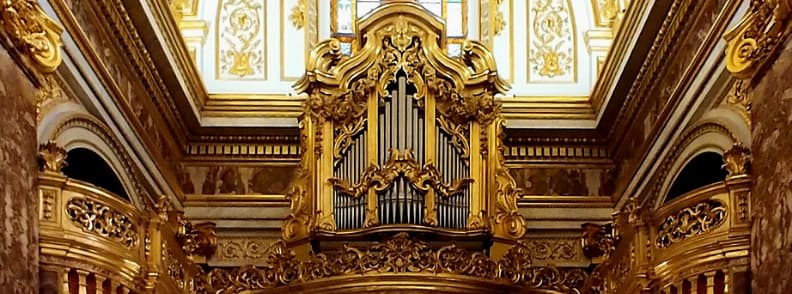
Church of Saint Anthony of the Portuguese (Chiesa di Sant’ Antonio dei Portoghesi)
Also known as Church of Saint Anthony in Campo Marzio (Chiesa di Sant’ Antonio in Campo Marzio). Located in front of Torre della Scimnia, this church is a ruin from Medieval Rome and a Baroque gem.
Tickets, opening times, and other useful information
Opening times
The Chiesa di Sant’ Antonio dei Portoghesi is open from Monday to Friday between 08.30 and 13.00, then between 15.00 and 18.00. On Saturdays, it is open between 08.30 and 12.00, then between 15.00 and 18.00. On Sundays, the church is open between 09.00 and 12.00.
Tickets
Admission to the Chiesa di Sant’ Antonio dei Portoghesi is free of charge.
Chiesa di Sant’ Antonio dei Portoghesi
Address: Via dei Portoghesi, 2, 00186 Roma RM, Italy | See on map
Public transport: Buses 70, 71, 87, 492, and 628 stop near Chiesa di Sant’ Antonio dei Portoghesi.
Tel. +39 06 888 0771
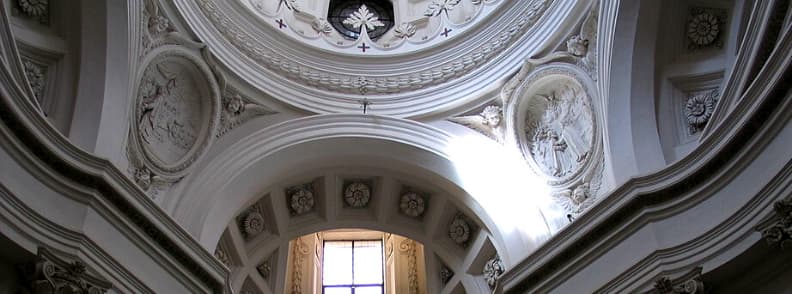
Church of Saint Charles at the Four Fountains (San Carlo alle Quattro Fontane or San Carlino)
San Carlo alle Quattro Fontane was built by Borromini in the 17th century. Having a small space at his disposal, he filled it with incredible decorations. Through his work, he managed to blur the line between architecture and sculpture inside this church in Rome.
Tickets, opening times, and other useful information
Opening times
San Carlo alle Quattro Fontane is open from Monday to Saturday, between 10.00 and 13.00. On Sundays, San Carlino is open between 12.00 and 13.00.
Tickets
Admission to visit San Carlo alle Quattro Fontane is free of charge.
San Carlo alle Quattro Fontane
Address: Via del Quirinale, 23, 00187 Roma RM, Italy | See on map
Public transport: Subway station Repubblica is close to San Carlo alle Quattro Fontane. Buses 64, 70, 71, 117, and 170 stop close to the church, as well.
Tel. +39 06 488 3261
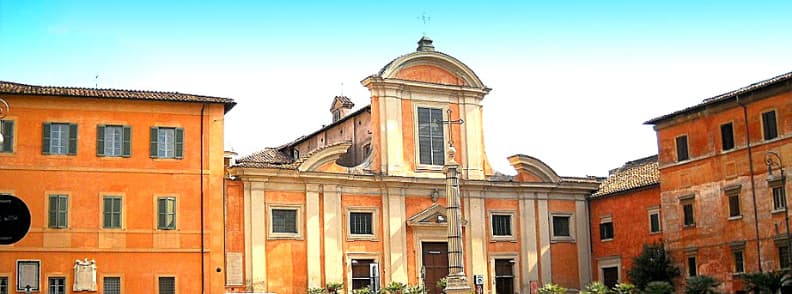
Church of Saint Francis at Ripa Grande (Chiesa di San Francesco a Ripa Grande)
San Francesco a Ripa Grande was built 12 years after St. Francis visited an asylum in this place, in the year 1219. Inside, in the last chapel to your left, you can find Beata Ludovica Albertoni, in a state of ecstasy at the limit to the erotic. This scandalous piece of art was done by Bernini, between 1671 and 1674.
If you plan to visit San Francisco a Ripa, ask to see where St. Francis lived. Inside his home, there is a copy of a portrait of his, painted by Margaritone d’Arezzo.
Tickets, opening times, and other useful information
Opening times
Chiesa di San Francesco a Ripa Grande is open daily, between 07.00 and 13.00, then between 15.00 and 19.00.
Tickets
Access to visit Chiesa di San Francesco a Ripa Grande is free of charge.
Chiesa di San Francesco a Ripa Grande
Address: Piazza di S. Francesco d’Assisi, 88, 00153 Roma RM, Italy | See on map
Public transport: Buses 3l, 44, and 75 and trams 3 and 8 stop near Chiesa di San Francesco a Ripa Grande.
Tel. +39 06 581 9020
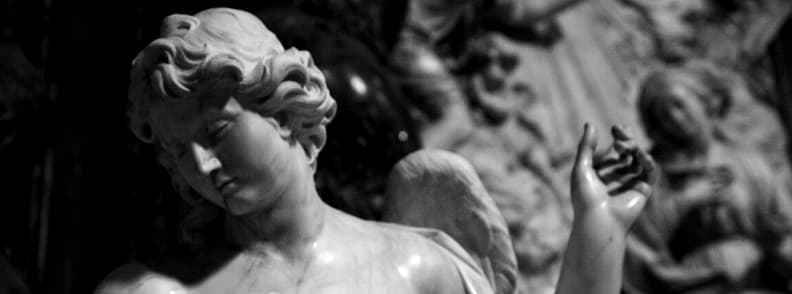
Church of Saint Ignatius of Loyola (Chiesa di Sant’ Ignazio di Loyola)
Chiesa di Sant’ Ignazio di Loyola is a Jesuit church finished in 1685. However, its dome was still missing. Andrea Pazzo made use of the trompe l’oeil technique to create the illusion of a dome over the flat ceiling of the church. He also is behind the elaborate ceiling, which travelers can admire it by looking into a huge mirror.
Tickets, opening times, and other useful information
Opening times
The Chiesa di Sant’ Ignazio di Loyola is open from Monday to Saturday between 07.30 and 19.00. On Sundays, it is open between 09.00 and 19.00.
Tickets
Access to visit Chiesa di Sant’ Ignazio di Loyola is free of charge.
Chiesa di Sant’ Ignazio di Loyola
Address: Via del Caravita, 8a, 00186 Roma RM, Italy | See on map
Public transport: Buses 62, 63, 83, 85, 119, 160, 492, and 628 will drop you near Chiesa di Sant’ Ignazio di Loyola.
Tel. +39 06 679 4406
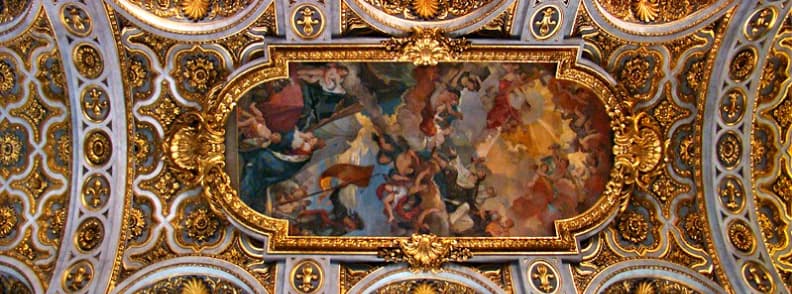
Church of Saint Louis of the French (San Luigi dei Francesi)
San Luigi dei Francesi is the national French church in Rome. Inside, visitors can discover the famous trio of Caravaggio with huge paintings in the chapel of St. Matthew. These paintings demonstrate how Caravaggio is moving away from symbolic pieces to more realistic ones. Among them, one can see St. Matthew and the angel. This is actually the second version of the painting, as the first was rejected by the church: the Saint had dirty feet and it was in strong contrast with the purity of the angel.
In the second chapel to the right, travelers will find frescoes by Domenichino, made between 1616 and 1617. However, they have deteriorated.
Tickets, opening times, and other useful information
Opening times
San Luigi dei Francesi is open from Monday to Friday, between 09.30 and 12.45, then between 14.30 and 18.30. On Saturdays, the church is open between 09.30 and 12.15, then between 14.30 and 18.45. On Sundays, San Luigi dei Francesi is open between 11.30 and 12.45, then between 14.30 and 18.45.
Tickets
Admission to visit San Luigi dei Francesi is free of charge.
San Luigi dei Francesi
Address: Piazza di S. Luigi de’ Francesi, 00186 Roma RM, Italy | See on map
Public transport: Buses 30, 70, 81, 87, 492, and 628 stop near San Luigi dei Francesi.
Tel. +39 06 688271
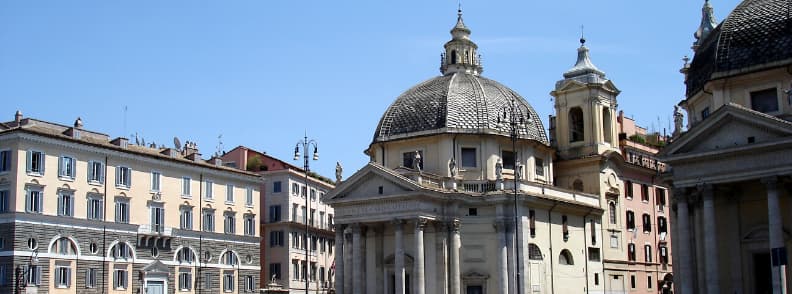
Church of Saint Mary in Montesanto (Chiesa di Santa Maria in Montesanto)
One of the twin churches in Piazza del Popolo, Santa Maria in Montesanto was built at the end of the 17th century by Carlo Fontana. Travelers will notice that it is more elaborated than Santa Maria Dei Miracoli. That is because Bernini helped with its decorations.
Tickets, opening times, and other useful information
Opening times
Chiesa di Santa Maria in Montesanto is open from Monday to Friday, between 10.00 and 12.00, then between 17.00 and 20.00. On Saturdays, the church is open between 10.00 and 12.00. And, on Sundays, Chiesa di Santa Maria in Montesanto is open between 11.00 and 13.00.
Tickets
Admission to visit Chiesa di Santa Maria in Montesanto is free of charge.
Chiesa di Santa Maria in Montesanto
Address: Piazza del Popolo, 18, 00187 Roma RM, Italy | See on map
Public transport: Bus 119 stops close to Santa Maria in Montesanto. The subway station Flaminio is within walking distance, too.
Tel. +39 06 361 0594
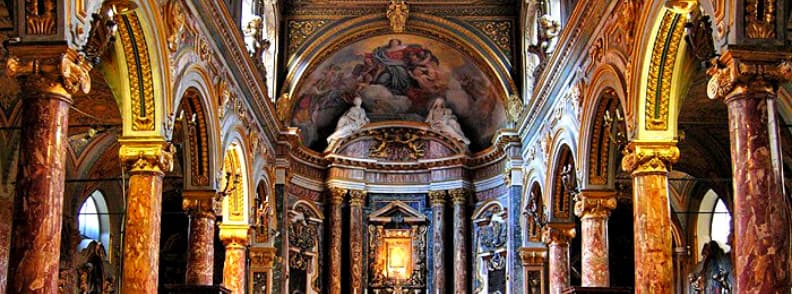
Church of Saint Mary in Via Lata (Chiesa di Santa Maria in Via Lata)
The vestibule and the facade of Santa Maria in Via Lata were done by Pietro da Cortona in 1660. The altar was made by Bernini between 1639 and 1643. Unfortunately, the original frescoes from the 16th century are no longer here, but they can be seen inside the Crypta Balbi in the National Roman Museum.
Tickets, opening times, and other useful information
Opening times
The Chiesa di Santa Maria in Via Lata is open daily between 17.00 and 21.30.
Tickets
Access to visit Chiesa di Santa Maria in Via Lata is free of charge.
Chiesa di Santa Maria in Via Lata
Address: Via del Corso, 306, 00186 Roma RM, Italy | See on map
Public transport: Buses 62, 63, 83, 85, 119, 160, 492, and 628 can drop you close to Chiesa di Santa Maria in Via Lata.
Tel. +39 06 8339 6276
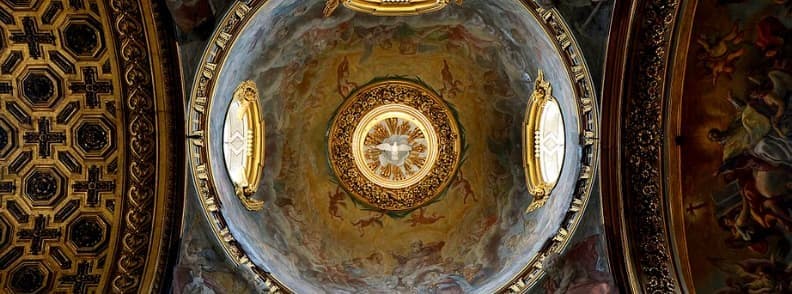
Church of Saint Mary Magdalene (Chiesa di Santa Maria Maddalena)
This elliptical Chiesa di Santa Maria Maddalena is considered the most beautiful Rococo monument in Rome. It was designed by Giuseppe Sardi, in 1735.
Tickets, opening times, and other useful information
Opening times
The Chiesa di Santa Maria Maddalena is open from Monday to Friday between 08.30 and 11.30, then between 17.00 and 18.30. On Saturdays, the church is open between 09.00 and 18.30. On Sundays, Santa Maria Maddalena is open between 08.30 and 11.30, then between 17.00 and 18.30.
Tickets
Admission to visit Chiesa di Santa Maria Maddalena is free of charge.
Chiesa di Santa Maria Maddalena
Address: Piazza della Maddalena, 53, 00186 Roma RM, Italy | See on map
Public transport: Buses 30, 70, 81, 87, 492, and 628 will get you within walking distance of Chiesa di Santa Maria Maddalena.
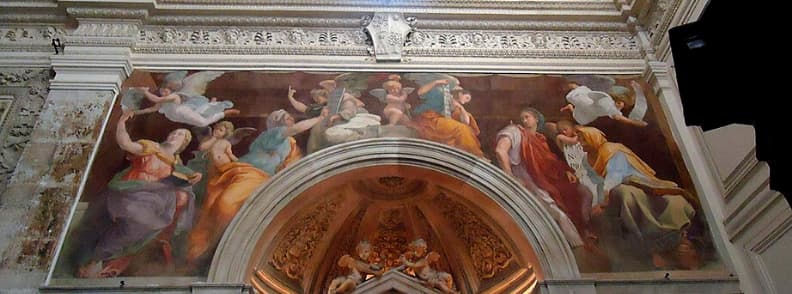
Church of Saint Mary of Peace (Chiesa di Santa Maria della Pace)
This church was rebuilt for Pope Sixtus IV between 1480 and 1484 by Baccio Pontelli. Its facade was made between 1656 and 1657, and its curved portico gave birth to a piazzetta. The interior of Santa Maria della Pace is obviously influenced by the Sistine Chapel in Vatican City, which had been recently inaugurated at the time.
The first chapel on the right was done by Raphael, who chose to paint it with cibillas in 1514.
Tickets, opening times, and other useful information
Opening times
Chiesa di Santa Maria della Pace is open daily between 09.30 and 18.30.
Tickets
Admission to visit Chiesa di Santa Maria della Pace is free of charge.
Chiesa di Santa Maria della Pace
Address: Arco della Pace, 5, 00186 Roma RM, Italy | See on map
Public transport: Bus 52 stops right next to Chiesa di Santa Maria della Pace.
Tel. +39 06 6880 4038
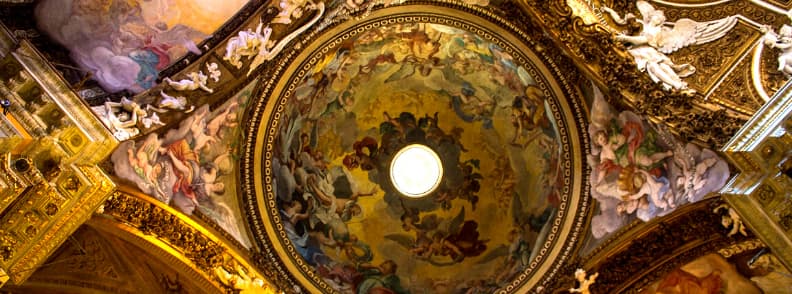
Church of Saint Mary of Victory (Chiesa di Santa Maria della Vittoria)
Santa Maria della Vittoria is an extravagant baroque construction from the 17th century. Mostly the work of Bernini and his pupils, it is probably the church with the richest decorations in Rome.
Inside, the most beautiful corner is the Cornaro chapel, to the left of the altar. Here is the shocking work of Bernini known as The Ecstasy of Saint Teresa.
Tickets, opening times, and other useful information
Opening times
Chiesa di Santa Maria della Vittoria is open daily between 07.00 and 12.00, then between 15.30 and 18.00.
Tickets
Admission to visit Chiesa di Santa Maria della Vittoria is free of charge.
Chiesa di Santa Maria della Vittoria
Address: Via Venti Settembre, 17, 00187 Roma RM, Italy | See on map
Public transport: Chiesa di Santa Maria della Vittoria is close to the subway station Repubblica. Buses 60, 61, 62, 84, 492, and 910 also have stops close to this church.
Tel. +39 06 4274 0571
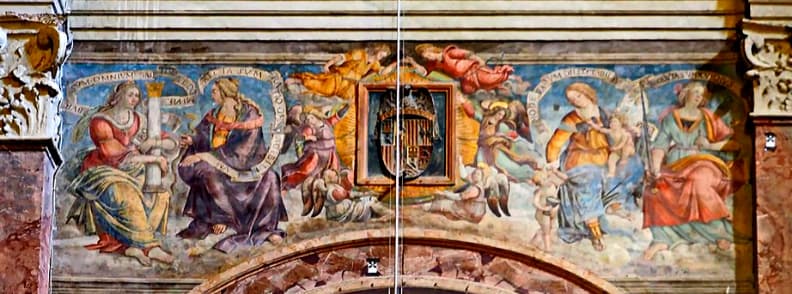
Church of Saint Peter in Montorio (Chiesa di San Pietro in Montorio)
The Tempietto from the yard of San Pietro in Montorio was done by Bramante. It is said to mark the spot where St. Peter was crucified.
Tickets, opening times, and other useful information
Opening times
Chiesa di San Pietro in Montorio is open daily between 09.00 and 12.00, then between 15.00 and 16.00.
Tickets
Access to visit Chiesa di San Pietro in Montorio is free of charge.
Chiesa di San Pietro in Montorio
Address: Piazza di S. Pietro in Montorio, 2, 00153 Roma RM, Italy | See on map
Public transport: Buses 115 and 870 stop close to Chiesa di San Pietro in Montorio.
Tel. +39 06 581 3940
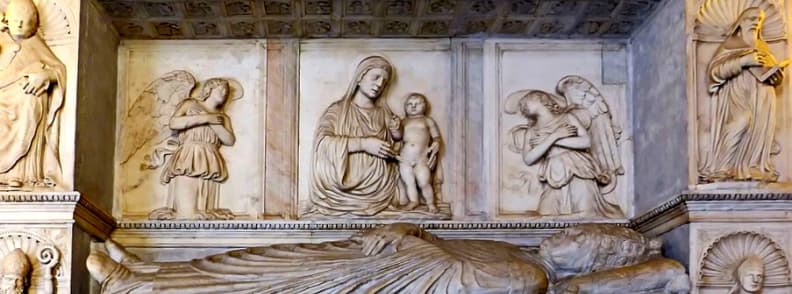
Church of Saint Salvatore at the Laurels (Chiesa di San Salvatore in Lauro)
San Salvatore in Lauro was founded in 1594. Inside one of its chapels, the main highlight is Pietro da Cortona’s Adoration of the Shepherds, an addition to the church made in the year 1623.
Tickets, opening times, and other useful information
Opening times
Chiesa di San Salvatore in Lauro is open daily between 09.00 and 12.00, then between 15.00 and 19.00.
Tickets
Admission to visit Chiesa di San Salvatore in Lauro is free of charge.
Chiesa di San Salvatore in Lauro
Address: Piazza di S. Salvatore in Lauro, 00186 Roma RM, Italy | See on map
Public transport: Bus 280 stops within walking distance of Chiesa di San Salvatore in Lauro.
Tel. +39 06 687 5187
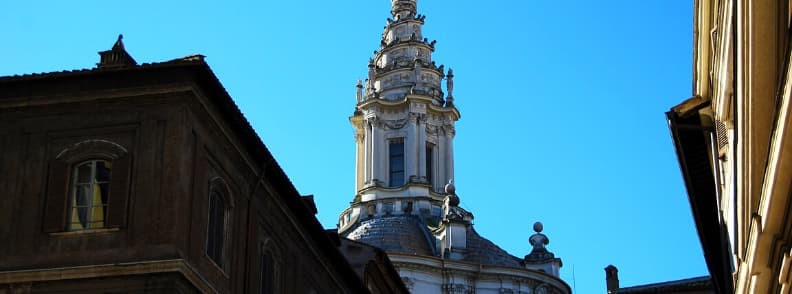
Church of Sant’Ivo alla Sapienza (Chiesa di Sant’Ivo alla Sapienza)
Sant’Ivo alla Sapienza has a Renaissance facade by Giacomo della Porta. He made it for Palazzo della Sapienza, the original location of the University of Rome. It has one of the most beautiful courtyards in Rome, where you will find wonderful double arches and an amazing play of concave and convex curves.
When the courtyard is closed, the dome can be seen from Piazza Sant’Eustachio.
Tickets, opening times, and other useful information
Opening times
Chiesa di Sant’Ivo alla Sapienza is open on Sundays, between 09.00 and 11.00.
Tickets
Access to visit Chiesa di Sant’Ivo alla Sapienza is free of charge.
Chiesa di Sant’Ivo alla Sapienza
Address: Corso del Rinascimento, 40, 00186 Roma RM, Italy | See on map
Public transport: Buses 30, 70, 81, 87, 492, and 628 stop next to Chiesa di Sant’Ivo alla Sapienza.
Tel. +39 371 313 6165
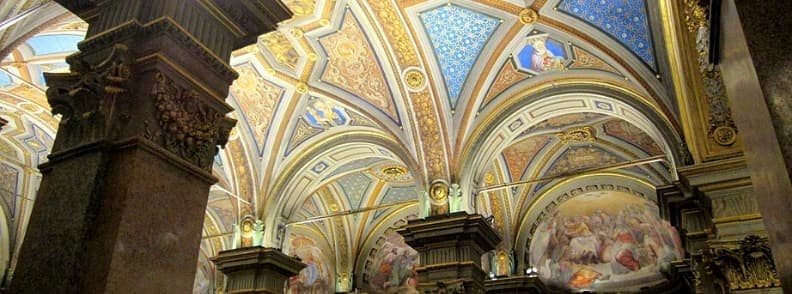
Church of Santa Maria dell’Anima (Chiesa di Santa Maria dell’Anima)
Inside Santa Maria dell’Anima, the main attractions are the altar by Giulio Romano and the tomb of Hadrian VI, made by Peruzzi in 1523.
Tickets, opening times, and other useful information
Opening times
Chiesa di Santa Maria dell’Anima is open daily between 09.00 and 12.45, then between 15,00 and 19.00. Closed on Wednesday mornings.
Tickets
Admission to visit Chiesa di Santa Maria dell’Anima is free of charge.
Chiesa di Santa Maria dell’Anima
Address: Via di Santa Maria dell’Anima, 64, 00186 Roma RM, Italy | See on map
Public transport: Buses 30, 70, 81, 87, 492, and 628 stop within walking distance of Chiesa di Santa Maria dell’Anima.
Tel. +39 06 682 8181
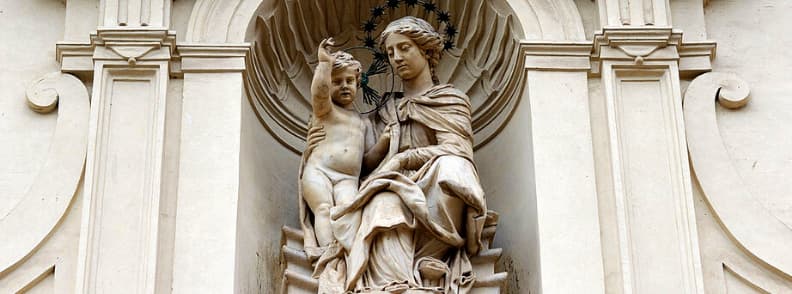
Church of Santa Maria della Scala (Convento di Santa Maria della Scala)
Santa Maria della Scala is built in the Renaissance style by Caravaggio and his pupils. Inside, its main attraction is the Madonna and the Child, by Cavalier d’Arpino (Caravaggio’s master).
Tickets, opening times, and other useful information
Opening times
Convento di Santa Maria della Scala is open daily, between 10.00 and 13.00, then between 16.00 and 19.00.
Tickets
Access to visit Convento di Santa Maria della Scala is free of charge.
Convento di Santa Maria della Scala
Address: Piazza della Scala, 23, 00153 Roma RM, Italy | See on map
Public transport: Buses 23 and 280 can drop you within walking distance of the Convento di Santa Maria della Scala.
Tel. +39 06 580 6233
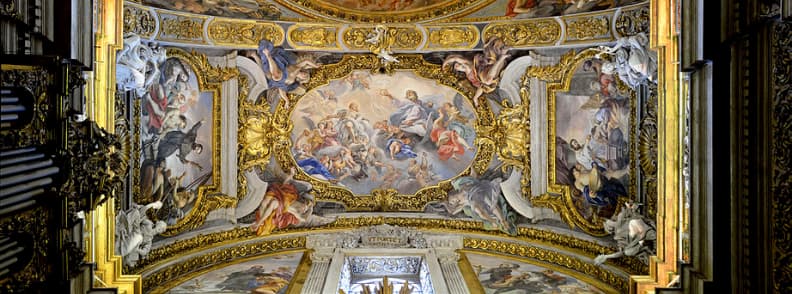
Church of Jesus (Chiesa del Gesù)
The Church of Jesus has an elegant facade and an amazing, heavily decorated interior. Its purpose was to show the power of the Jesuit order.
A miraculous opening in the roof shows angels being absorbed into Paradise. Inside, you can also see the tomb of Ignatius, the founder of the Jesuit order, decorated with large lapis lazuli stones.
Tickets, opening times, and other useful information
Opening times
Chiesa del Gesù is open daily between 07.00 and 12.30, then between 16.00 and 19.45.
The rooms of the Holy Ignatius are open daily between 16.00 and 18.00.
The museum is open on Saturdays between 16.00 and 18.00.
Tickets
Access to visit Chiesa del Gesù and the rooms of the Holy Ignatius is free of charge.
Chiesa del Gesù
Address: Via degli Astalli, 16, 00186 Roma RM, Italy | See on map
Public transport: Buses 40, 46, 62, 64, 70, 81, 87, 492, 628, and 916 stop close to Chiesa del Gesù. Tram 8 will also leave you within walking distance of the church.
Tel. +39 06 697001
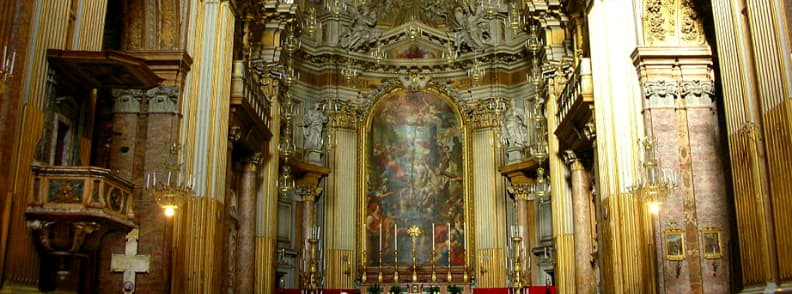
Church of the Holy Apostles (Basilica dei Santi Apostoli or Basilica dei Santi Dodici Apostoli)
The 6th-century Basilica dei Santi Apostoli was raised between 1702 and 1708. It has an interesting art in trompe l’oeil above the altar.
Tickets, opening times, and other useful information
Opening times
Basilica dei Santi XII Apostoli is open daily, between 07.00 and 12.00, then between 16.00 and 19.00.
Tickets
Access to visit Basilica dei Santi XII Apostoli is free of charge.
Basilica dei Santi XII Apostoli
Address: Piazza Santi Apostoli, 51, 00187 Roma RM, Italy | See on map
Public transport: Buses 40, 64, 62, 63, 64, 70, 80, 83, 85, 119, 160, and 492 can get you near Basilica dei Santi XII Apostoli.
Tel. +39 06 699571
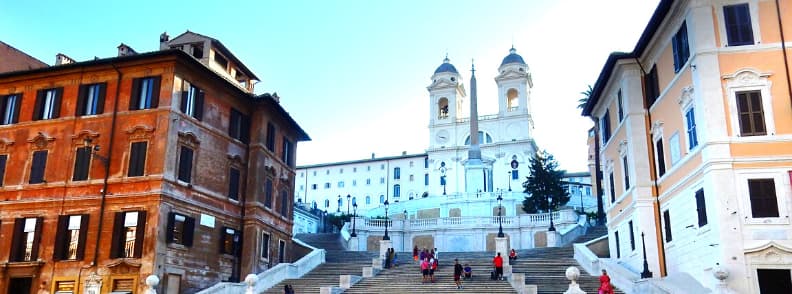
Church of the Trinity of the Mounts (Santissima Trinità dei Monti)
Crowning the Spanish Steps, Trinità dei Monti is part of a monastery complex, that was founded by King Louis XII in 1503. Giacomo della Porta designed its Facade with twin towers in 1584 and Domenico Fontana created the double staircase in 1587.
Inside Trinità dei Monti, travelers can find frescoes by Daniele da Volterra in the chape to the right, together with a painting by his master, Michelangelo.
Tickets, opening times, and other useful information
Opening times
Santissima Trinità dei Monti is open from Tuesday to Friday between 07.30 and 19.00. On Saturdays and Sundays, it is open between 10.00 and 17.00. Closed for turists during masses.
Tickets
Admission to visit Santissima Trinità dei Monti is free of charge.
Santissima Trinità dei Monti
Address: Piazza della Trinità dei Monti, 3, 00187 Roma RM, Italy | See on map
Public transport: Subway station Spagna is right next to the Santissima Trinità dei Monti. Bus 119 can also take you to visit this church.
Tel. +39 06 679 4179
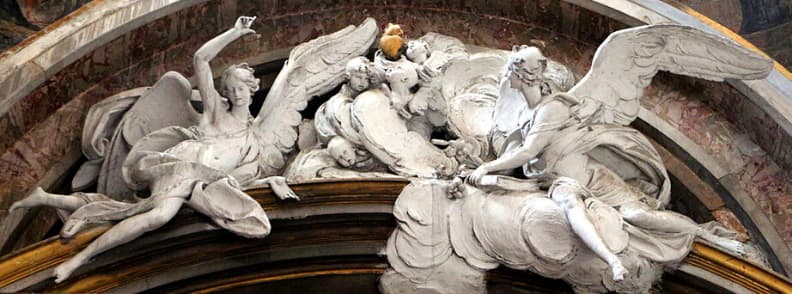
Minor Basilica of Saint Lawrence in Lucina (Basilica Parrochiale San Lorenzo in Lucina)
San Lorenzo in Lucina was founded in the 5th century and then renovated between the years 1090 and 1118. Guido Reni is the one who worked on the Crucification altarpiece, and Bernini’s craft can be seen in the second chapel on the right.
Tickets, opening times, and other useful information
Opening times
San Lorenzo in Lucina is open daily, between 08.00 and 20.00.
The underground can be visited at 16.30 on the last Saturday of each month.
Tickets
Access to visit San Lorenzo in Lucina in free of charge.
Basilica Parrochiale San Lorenzo in Lucina
Address: Piazza di S. Lorenzo in Lucina, 6, 00186 Roma RM, Italy | See on map
Public transport: Bus 119 will take you within walking distance of San Lorenzo in Lucina.
Tel. +39 06 687 1494
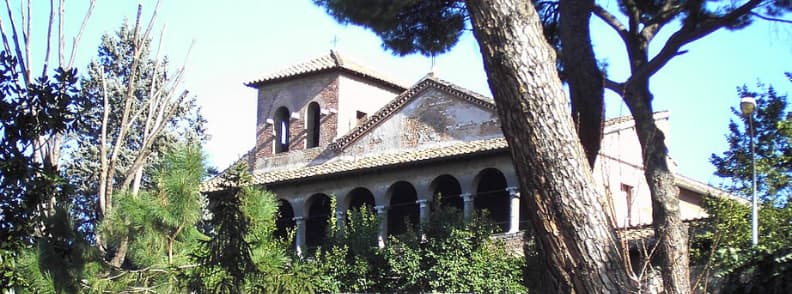
Minor Basilica of Saint Saba (Chiesa di San Saba)
San Saba was at first a 7th-century oratory for Palestinian monks that were exiled from their country. Today, it is a renovated church with new elements added in the 10th century.
Besides the floors made in the style of the Cosmati artisans, San Saba also has an interesting 13th-century fresco of St. Nicholas. He is portrayed as he is about to throw a bag full of gold over 3 bare naked girls that are lying on a bed. He’s actually saving them from prostitution.
Tickets, opening times, and other useful information
Opening times
San Saba is open on Mondays and Thursdays between 10.00 and 12.00, then between 16.00 and 18.00. On Tuesdays, Wednesdays, and Fridays, the church is open between 10.00 and 12.00. Closed on weekends.
Tickets
Admission to visit San Saba is free of charge.
San Saba
Address: Piazza Gian Lorenzo Bernini, 20, 00153 Roma RM, Italy | See on map
Public transport: Bus 715 stops next to San Saba.
Tel. +39 06 6458 0140

Orthodox Church of Saint Theodore at the Palatine Hill (Chiesa Ortodossa di San Teodoro al Palatino)
On the base of Palatine Hill, there is a small circular church dating back to the 16th century. It’s San Teodoro al Palatino, one of the hidden gems of Rome.
Inside San Teodoro, there is an original mosaic showing Christ sitting on the Globe. Other parts of the church, such as the Florentine dome, show elements added during the 15th-century renovations ordered by Pope Nicholas V.
Tickets, opening times, and other useful information
Opening times
San Teodoro is open from Sunday to Friday between 09.30 and 12.30. Closed on Saturdays.
Tickets
Admission to visit San Teodoro is free of charge.
Chiesa Ortodossa di San Teodoro al Palatino
Address: Via di S. Teodoro, 7, 00187 Roma RM, Italy | See on map
Public transport: Buses 51, 81, 85, 87, 118, 160, 628, and 715 stop near Chiesa Ortodossa di San Teodoro al Palatino.
Tel. +39 06 678 6624
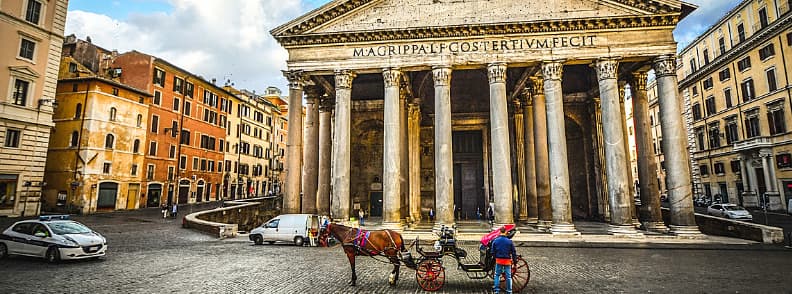
Pantheon (Panteono)
The first Pantheon was built on this ground in 27 BC, by Marcus Agrippa, Emperor Augustus’s son-in-law. However, this construction burned to the ground, and only after that was the Pantheon built almost as we now know it.
Emperor Hadrian replaced the rotunda between the years 118 and 125. In 608, Emperor Phocas donated this pagan temple, dedicated to all gods, to Pope Bonifacio IV. He was hoping that this wonder of Ancient Rome will be better preserved as a Christian church.
Despite being robbed of the gold on its roof by Constantine II, of the bronze panels of the portico by Pope Urban VIII, and of anything that could be carried by barbarians, the Pantheon remains the best-preserved construction out of all the ancient temples in Rome.
This wonderful building has stood the test of time. While other monuments in the world have crumbled, thanks to the brilliant design and engineering skills of those responsible for this strikingly majestic monument, the Pantheon remains intact today.
The Pantheon has a structurally imposing entrance, designed in the form of a rectangle. In the granite pillars that bear a triangular pediment, the classic Greek influence is clear. A rotunda, topped by a dome, leads into the entrance. Three rows of Corinthian pillars are at the entrance to the circular space. Of these, eight are built in front, followed by eight more in two pairs. You are carried into the rotunda by this magnificent rectangular entrance.
It is evidence of the sound architectural expertise, the combination of materials used and the accuracy to which the building was carried out that the circular framework should be able to hold up a 142-foot diameter dome for so many years. An opening called the oculus is at the center of the dome. Not only does this clever idea allow light to penetrate the structure, but it also helps to uniformly distribute the weight. There is one downside: the rain has free access to the interior as well. By sloping the floor in the direction of the drains, that too was catered for.
Every element of the building was designed carefully. Equally impressive is the design of the steps. They are tapered in such a way that the foundation is heavier than the tip, which is 20 foot thick. The steps decrease in weight until they reach the oculus, where they are only 7.5 feet thick and weigh less. This brainwave of the architects concerned was not picked up by potential builders, although it might seem odd.
While the builders were handicapped in those days, without the help of computers and high-precision instruments, they were nevertheless able to erect a monument that had been standing for almost 2000 years. Besides, transportation wasn’t advanced. Via the River Tiber, the only way they could transport the materials was. The construction materials will have to be mounted on carts on land and dragged to the site by man or beast.
The surprising thing about the Pantheon is that, despite having been constructed on marshy soil, no significant maintenance work was carried out on the building, except for the renovation of its huge bronze doors. In contrast, several renovations have been made to the leaning Tower of Pisa, in an effort to prevent it from collapsing. For this, the soft ground on which it was constructed was blamed.
Copies of the pantheon have been tried. Examples include the Reading Room at the British Museum, as well as the rotunda named after Thomas Jefferson at the University of Virginia. However, in beauty and structural elegance, the Pantheon transcends each replica made of it.
The Pantheon has been put to good use at all times. Many prominent individuals have been buried there, including monarchs. The Pantheon has been used as a church from the eighth century to the present day.
Place the Pantheon at the top of your must-see list if you get a chance to visit Rome. The effort is well worth it!
What to see inside the Pantheon
- The dome is the largest one built in all of Europe. It has a height and a diameter of 43.3 meters.
- The Oculus, located in the middle of the dome has a diameter of 8.3 meters. Through it, the Pantheon is permanently open towards the sky. And, as the Pantheon has no windows, the Oculus is the only source of natural light in the entire building.
- The triangular portico rests on 16 columns made of granite. Except for three columns to the left, all the rest are the original ones.
- The brass doors of the Pantheon are still the original ones. However, they have undergone several massive works of restoration.
- Tombs inside the Pantheon. Vittorio Emmanuele II and his son, Umberto I, the first to have unified Italy, have their tombs inside the Pantheon. Raphael’s remains also rest in one of the huge tombs inside the Pantheon’s building. His is a simple tomb, made out of stone.
If you’re traveling to Rome in the low season, keep in mind that the Pantheon is an interesting place to see even when the weather isn’t fair. On a rainy day at the Pantheon, water drops inside through the Oculus, then trickles on the floor into a trough. Snow falling through the Oculus also makes for a special sight.
Tickets, opening times, and other useful information
Opening times
The Pantheon is open from Monday to Saturday between 08.30 and 19.30. On Sundays, it is open between 09.00 and 18.00.
Tickets
Admission to visit the Pantheon in Rome is free of charge.
Pantheon
Address: Piazza della Rotonda, 00186 Roma RM, Italy | See on map
Public transport: Subway line A can take you to the nearby Barberini station.
Tel. +39 06 6830 0230
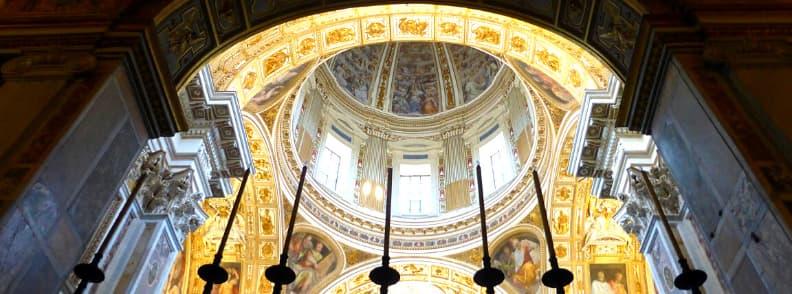
Papal Basilica of Saint Mary Major (Basilica di Santa Maria Maggiore)
The 5th-century Santa Maria Maggiore is one of the largest ones in Rome. Inside, travelers can find a unique mixture of architectural styles. There are mosaics from the 5th century in the style of the Cosmati artisans. the bell tower was raised in the Romanesque style, and the ceiling with gold from the New World is from the Middle Ages.
Pope Sixtus V placed an Egyptian obelisk outside, in 1587. Since then, it has been a landmark for pilgrims.
Tickets, opening times, and other useful information
Opening times
The Basilica di Santa Maria Maggiore is open daily between 07.00 and 18.45.
The museum is open between 09.00 and 18.30.
Tickets
A full general admission ticket costs €3.00.
Reduced tickets cost €2.00 and are available for students and senior citizens.
Basilica di Santa Maria Maggiore
Address: Piazza di S. Maria Maggiore, 00100 Roma RM, Italy | See on map
Public transport: The subway station Termini is a 10-minute walk from Basilica di Santa Maria Maggiore. Buses 16, 70, 71, and 714 also have stops in the area.
Tel. +39 06 6988 6800
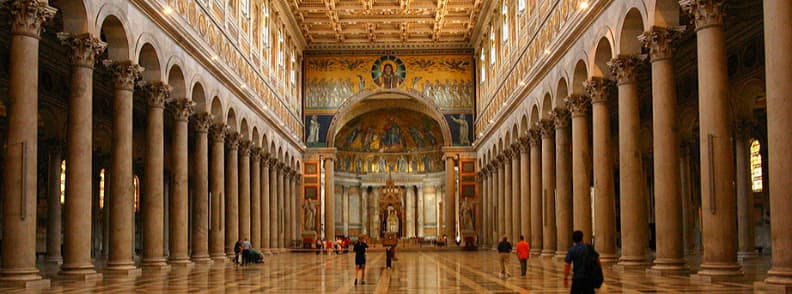
Papal Basilica of Saint Paul Outside the Walls (Basilica Papale San Paolo fuori le Mura)
Despite the pompous name, the Papal Basilica of Saint Paul Outside the Walls is a simple construction from the 19th century. It survived a fire in the 4th century and it remained impressive.
Inside, one can still see some of the 5th, 12th, and 13th-century mosaics that have survived to this day. That is also valid for the bronze door from the 11th century.
Tickets, opening times, and other useful information
Opening times
The Basilica Papale San Paolo fuori le Mura is open daily, between 07.00 and 18.30.
The cloister is open daily, between 09.00 and 18.00.
Tickets
Admission to the Basilica Papale San Paolo fuori le Mura is free of charge.
However, a full admission ticket to visit the cloister costs 4.00.
Basilica Papale San Paolo fuori le Mura
Address: Piazza di S. Maria Maggiore, 00100 Roma RM, Italy | See on map
Public transport: The subway line B can take you to the San Paolo station. Buses 23 and 271 also stop near Basilica Papale San Paolo fuori le Mura.
Tel. +39 06 6988 6800
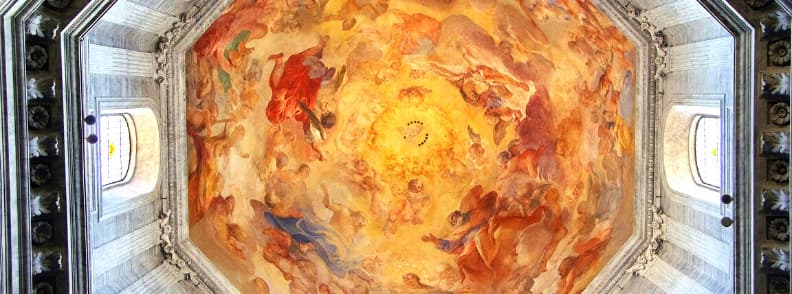
Parish Basilica of Santa Maria del Popolo (Basilica Parrocchiale Santa Maria del Popolo)
Legend has it that on this place, under a grand oak, emperor Nero died and was buried. Until 1099, the place was considered cursed and people kept away. However, that year, Pope Pascal II had a vision of the Virgin Mary, who told him to cut the oak, remove the emperor’s remains and raise a church on that spot.
Raised over the emperor’s tomb, Santa Maria del Popolo has some of the richest works of art of the Renaissance and the Baroque. Among their authors, travelers can recognize Bernini, Bramante, Caravaggio, Pinturicchio, and Rafael.
It’s actually one of the few churches in Rome where the main chapel remains intact, conserving works of art that display full stories. Other Italian chapels were destroyed over time, and their works of art can now be seen only inside museums.
Some of the treasures of Santa Maria del Popolo are behind the Superior Altar. During sermons, this place is occupied by the choir. The rest of the time, however, one can go behind the curtain to the left of the altar to admire them.
Tickets, opening times, and other useful information
Opening times
Basilica Parrocchiale Santa Maria del Popolo is open from Monday to Thursday between 07.15 and 12.30, then between 16.00 and 19.00. On Fridays and Saturdays, the basilica is open between 07.30 and 19.00. On Sundays, Santa Maria del Popolo is open between 07.30 and 13.30, then between 16.30 and 19.30.
Tickets
Access to visit Santa Maria del Popolo is free of charge.
Basilica Parrocchiale Santa Maria del Popolo
Address: Piazza del Popolo, 12, 00187 Roma RM, Italy | See on map
Public transport: Subway line A can take you to the nearby Flaminio station. Buses 95, 117, 119, 490, 495, and 926 also stop close to the Basilica Parrocchiale Santa Maria del Popolo.
Tel. +39 06 361 0836

